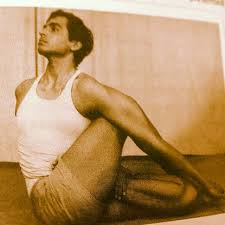STAY !

Zoom Yoga has brought many opportunities to study with our Iyengar Yoga teachers in India. Along with Prashant and Abhi’s special classes, I have been taking a weekly class with Gulnaaz Dashti, a teacher and student at the Iyengar Institute and someone I have taken numerous classes with in her own studio space also in Pune. The teaching by Indian teachers is distinct and effective, and Gulnaaz has a refrain that she repeats often after an instruction in a pose, “STAY!”. This is something that I am not sure would go over so well in an American class, though I find it engaging and absorbing, and Prashant spent this past weekend clarifying why this demand is and should be used for our educative process in yoga.
To “stay” in a pose is not about time or stamina, it is about inquiry, knowledge, and sensitivity. To “stay” is to engage in the more covert principles of what yoga has to teach us instead of being stuck in the overt technicalities. “Principles in yoga are unchanging truths, but the techniques of yoga change for all sorts of reasons and applications”. We have allowed the overt techniques of physical posture to eclipse our true education in yoga. We take for granted that the body, mind, and breath are all in sync and always involved.
People get confused or put off by Prashant in his lack of technique in posture and sequencing. He uses asana as the means of education and not just for doing, so his classes look and feel completely different to what we are used to here. Even as he is explaining all the reasons why he does what he does or laughingly acknowledges that we are all sitting there “waiting to do something”, folks still miss the point and complain that we only repeat three or four poses in a class.
“Repetition of asana with new avenues of thought facilitates the creation of room and space, encouraging response, involvement, and participation of body, mind, and breath.”
Paraphrased Prashant Iyengar – July 2020
We repeat and we stay. In Prashant’s Pune classes you make rounds around the hall, alternating typically between a standing pose, a seated pose, and something on the ropes. Each of the poses chosen brings a different space for exploration and each time you cycle back to it it is something new. Yes, maybe the same posture, but definitely a different asana. The word “asana” is translated not as “pose”, but as a “seat” in Sanskrit. And, the definition of yoga has nothing to do with asana, but with the citta, the consciousness. Yoga exploration is for the “stilling of fluctuations within the consciousness”.
“In different containers, water always settles down and balances out. In any asana, we must stay long enough for the conscious to settle like water in the container, otherwise it continues to be disturbed. Asanas are a seat for the consciousness. All asana must become Savasana”
Paraphrased Prashant Iyengar – July 2020
It is our responsibility as yoga students to be curious and explore, not just accomplish. He made an observation that the word for “do” in Hindi is “karana”, surprisingly like Corona. To keep “doing and doing and doing and doing” leads us to dying. Can we learn to “stay” in our practice to reap the benefits of ultimate freedom and absorption in Yoga?
The image chosen is of Paripurna Matsyendrasana (full Lord of the Fishes pose). After doing a lot of twisting poses in the class, Prashant talked a bit about the efficacy of twists on awakening the Kundalini energy that lies dormant at the base of the spine. Noting again that this is not something that “just happens by doing”, but requires time and attention for full involvement and participation.